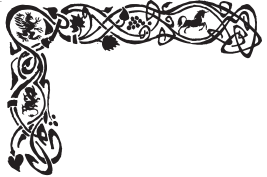Man creates facts but man and woman also create symbols. The intellectual genesis of Wonder Woman from a bohemian cult of liberation is probably fairly well known, or is it? The usually designated founder, Dr William Marston, lived in a commune-style setting with classicist ElizabethHolloway, bondage specialist and artist Marjorie Huntley, proto-feminist Olive Byrne (and others).
The persona of Wonder Woman sprang from all four. The utopian idealism of Byrne (Paradise Isle), the classical discipline of Holloway. Marston’s patriotic fervor. As for bondage Huntley actually called it “love binding” and suggested that women,
Expose their bodies and use various legitimate methods of the Love Sphere to create in males submission to them. (The Secret History of Wonder Woman, Jill Lepore)
It seems to me that pre-liberated women of the time of Jane Austen – or Fielding’s Moll Flanders even more so – dressed as they were in bloomers, bustles, corsets did this. Moll Flanders displays feminine wiles and power dressing to make the supposedly male –oriented world her oyster. Basically, female bodies were bound in various ways and, given the socio-cultural context, they were able to display their power.
This power is primarily action; the flow of body and fabric, the social round of a Puritan settlement. Now, the curves of a body (Cosmic Curmudgeon) are symbols not facts. This is a symbolic power, but in the context of a wilderness-style commune, where symbols reign, it is real power.
I mean, the context we’re talking about is the universe at large; the stars at night, bats flapping at dusk, the cockerel crowing at dawnrise. We’re no longer in the world of fact, aka talking-heads; How much power is there in “the power to sit still”?
There are other factors at play. In the west Calamity Jane types will prevail, and this harkens back to Grace Slick’s advocacy of 50s heroine’s like Betty Grable (CH 5). They can act in a masculine way while retaining their feminine credentials. The world they act in is much more flowing, full of bustle, displays like birds, peacocks on parade (need I mention Indians?)
This world is actually overtly symbolic. There are much fewer facts there. This brings in another aspect of the 50s, that it was the era of paranoia. EC sci-fi comics are full of stories of Martian infiltration of the higher echelons of government and defence.
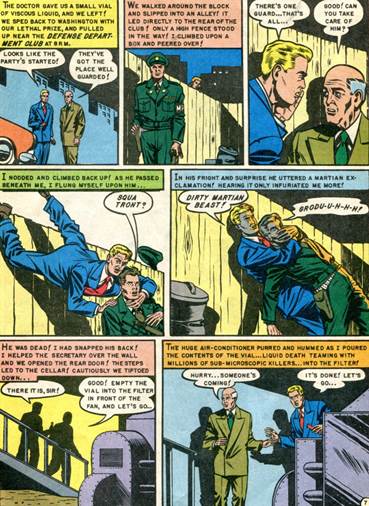
Weird Fantasy 15, Al Feldstein
You remember awhile ago Trump put out a tweet with the word “covfefe”? What if this unknown word is Martian language? I’m not alone in thinking this way; it’s the premise of Carpenter’s B-movie homage They Live! Yes, I know we’re talking fantasy but – see CH 4 – psychotic fantasies or delusions are evidence of the subconscious, even of a group unconscious. Why is it that political heads are often so oddly shaped. There’s Trump’s hair, but also Putin of the iron brow, Geert Wilders of the fantastically elevated forehead ala Sinestro of the Yellow Lantern Corp. The women aren’t much better; Angela Merkel has perfected a frau’s scowl, Christine Lagarde is like someone from The Wizard of Oz, Janet Yellen is a miniature Cheshire Cat..
I’m not being needlessly insulting; these people live in their heads and have developed techniques for accentuating their profiles. It’s not rocket science; the camera likes to detect movement or distinguishing features. However, while we’re looking at their heads, the pop stars are singing of a “fat and round” future that is very likely not there atall. What I like about 60s lyrics is the socio-cultural meaning, symbolic of rebellion in dress, style (introspective consciousness).
SHE HAS FUNNY CARS
In past eras – even in the 60s – there was an interplay between society and songs since the SONGS were essentially the settings for society (see Alternates 4). The societies were much less political-factual and much more symbolic-cultural (this also comes into the films of Lindsay Anderson, particularly O Lucky Man with the minstrel Alan Price Alternates 2,3).
Language itself can become a sort of empty ritual that only has a technical use and no symbolic content. The institution becomes archaic (If ). The way out of this situation is to disestablish institutions and take them back into truly symbolic settings. What I’m really getting at is the symbolic settings, the universe at large, the bustle of society.. none of that is factual. When the talking heads come along they bring with them their universe of facts. But facts might as well be from Mars, and get weighed-down with empty rituals. Perhaps the conformist 50s saw this coming and invented these languages like “squa tront” and the B movie paranoia?
The “Martian head” phenomenon is just subconscious fantasy, but it could yet be a psychotic reality; the subconscious is as much part of reality as the ego. It’s not as if there’s some global conspiracy; as Alan Moore says, there are no conspiracies, no one is in charge and that’s the scary thing.
This is a way of exercising symbolic control in a symbolic universe. We are of the universe and owe no political allegiance to Martian infiltrators. Don’t worry, it’s a figure of speech; I mean the psychotic overlords. There’s no need to bandy words. Once on the trail is the time for words, because the sense of symbolic reality will then become a new order, one of vision and dress and not of inert fact.
There’s an old cartoon by Jack Davis of the cowboy as ideal and real
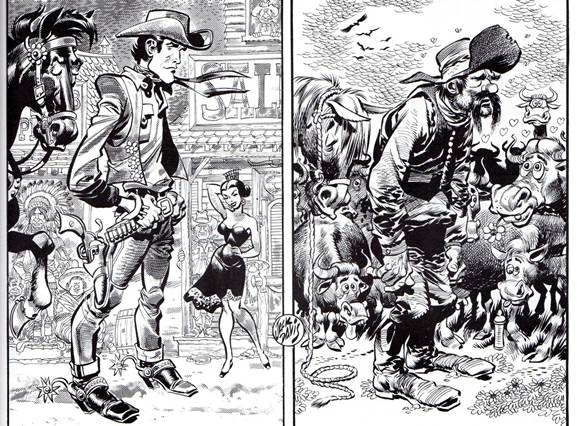
There are a lot of images like that I could “quote” at you – not only of the west but all over the place. There are shocking tales of the Wild West rough-and-tumble no holds barred “gougers” who grew into almost beasts of prey.
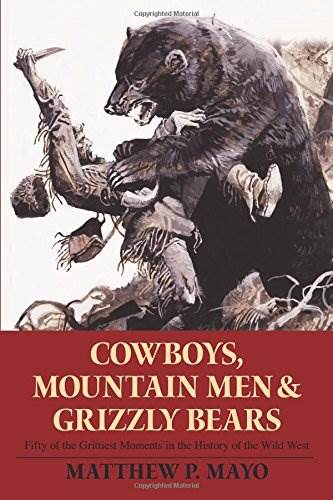
The dress that is loose, rugged and picturesque is another facet of a symbolic order where action and body language are more beast-like. Comic books are quite good at this; BWS’s Archer and Armstrong is a pastiche of Dumas.
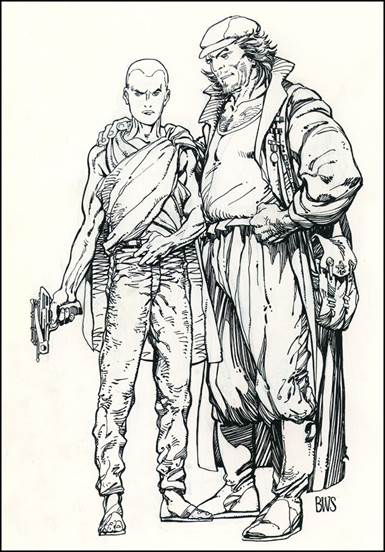
There’s a picture from Planetary that captures this jodhpur-like gear (and we all know about men in tights).
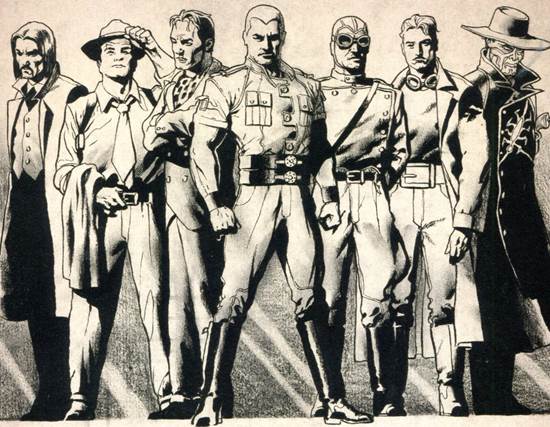
The Chinaman’s pantaloons, straw hat and cane exert a hold on the popular imagination, as does the Japanese samurai. So, the manly garb has a tendency to be very loose-fitting, with the odd buckle or binding, as with Conan’s emblematic sandals. Where does all this get us? That dress is there to facilitate action. I think the same applied to women generally. The social milieu, the bustle of society, was facilitated by loose dress as well as love-binding in women. That makes the society very much more of a symbolic order of flowing grace.
When the men (predominantly) in suits and ties moved in, that was probably a sign that the universe of fact and ritual language had arrived. This seems to be a feature of 50s comicstrip Lil Abner, where the hill billies are dressed in quaint clobber and bovver boots, as distinct from the greasy city-slickers.
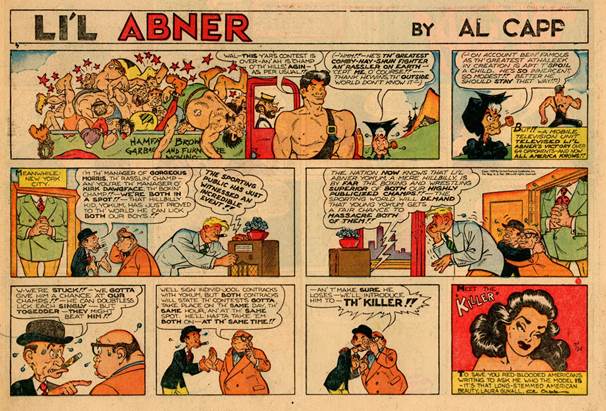
The way to reproduce that effect is to disestablish institutions that are corrupted by this complicated ritual – the “Martians” – and take them back into symbolic settings. This could be National Parks.
By “institutions” I could mean schools or shops or villages or banks. The general dress-code in the new territories could even be Puritan as a type of revival of countrified gentility. CC Beck has a quote on dress which is pretty interesting.
I’ve often said when we used stereotypes if you went into a hockshop there was always a Jew behind the counter.. Went into a bank, there’s an old conservative guy with a Hoover collar, he wasn’t sitting there in blue jeans and a T-shirt. And you knew where you were and you could go to the next panel and show a typical farmer with a straw hanging out of his mouth and bare feet..”
In other words, a suit and tie suits a banker, but when the dress becomes so standardised you tend to think we’re being run by bankers (which we are.) The dress tends to fit the activity of the society. In our society there is no activity so we dress accordingly, purely for show. In the new territories, the dirt and saddle-sore environs of the trail take their toll and one needs tough, flexible wear. Basically, for the same reason horses need shoeing.
There’s a very cute quote from a French short story where the shapes of animals, of criss-cross carts in a town square (a la Tati) impinge on humans.
It was a black horse with a glossy coat, one of those half-breds the peasants used to harness to their wagons. It had just been shod, and the blacksmith was taking his tools into the forge when the horse set off towards the middle of the square without the blacksmith’s son, who had untied it, making a move to catch it.
The baker’s wife was running across the square. She saw the horse coming towards her. It was moving slowly with the clatter of its new shoes which made its progress more nervous. The woman took shelter in the coach-house. Probably associating the gloom inside the wide doors with a stable, the horse went up to it..
Then I saw the blacksmith’s son come forward. He didn’t run. He walked fairly quickly and a little stiffly, and his face had the strained look and the pallor of someone who has just hurt himself and is going to bleed any second. He went up to the horse and stayed there motionless staring at the baker’s wife. For her part she stared at him intently too. Several people in the sqaure were at their doors: they watched the situation in silence..
And suddenly, as if penetrating the deep shadow from which I was emerging, as if it was finally intended amid so many unnamed realities, something began to exist in my mind. I understood that everything that lived in that animal, the burden of strength, the whinnies as yet unleashed, the dream of a space freer than space, everything that was held in check was in this man and woman, who face to face stared at each other in silence. Pierre Gascar, Le Petit Place
In building a traditional settlement as with a Tati-esque quartier, in building a house in the woods, one is communing with shapes, symbols of the universe. There’s a quote from some guy like William Morris (art nouveau) that overlapping rooftiles on some cottage reminded them of fish-scales. Grace Slick has some cute comments on living in “1798
Everything you see in the room is handmade, including the big wooden crossbeam supporting the troweled ceiling.. While you and your dog enjoy the warmth of the big stone fireplace, you read a few pages of an essay on freedom by Thomas Jefferson. Then you both climb the Dutch-tiled stairs.
Or 1998”
The ceiling is wall-to-wall twenty year-old white cardboard tiles. The dresser amounts to four plywood drawers you were forced to assemble from twenty-seven separate pieces that came in a box marked Ikea, which spit Styrofoam balls. You can switch the seventy-five-watt track floodlights ona nd off by pushing a button on a plastic panel on your metal headboard, which features rows of electronic remote units. (Somebody to Love? Page 23-25)
So you’re in the hills, with a chainsaw, you cut down your white conifer, hook it up to a horse, walk forty seven meters or so and start building your house by the roadside (not forgetting the rawhide door). Lumber, some square-cut stone, walls of adobe, a corral rising to the east, an abode as symbol of western living.
This is yet another case of the two alternate futures deviating as far as it is possible to deviate. The future “they” envisage is of houses full of sound, barked comments at smart gadgets all tailored to you, the lucky resident. This is a house that is inward-turning to a fault (Metamorphosis); there is no key to the wider universe.
As I’ve been saying for awhile, that future is philosophically weak, even psychotic. The home in the woods is eerily silent, and therefore hears the sounds of the universe. It is outward-looking. You could imagine style items like wooden turntables, rugged wearable vinyl acoustics.
In the new territories, the dream of the universe is much more visible and audible, so the house as metaphor for living becomes more real. The French have a phrase “vous fabriquez”, meaning you’re making it up. The modern world seemingly fabricates houses while trampling on the more shambolic houses as dreams for living in. The old brownstone tenements of New York (Bardot).
The “smart house” shuts off the dream as surely as the click of a switch. That future is weak and vision-free, whatever “they” tell you, there is no advantage in losing the dream no matter what the worth in bribes. A home is silent like the forest and should ever be so; that is the link with the dream. This is made very apparent in this quote from REH.
(Camp Colorado) stands upon the foundations of the old army commissary and many of its doors and much of its flooring came from the old government buildings, the lumber for which was freighted across the plains three-quarters of a century ago. The doors, strong as iron, show plainly, beneath their paint, the scars of bullets and arrows, mute evidence of the days when the Comanches swept down like a red cloud of war and the waves of slaughter washed about the adobe walls where blue clad iron men held the frontier.
In the wilderness it's not a bad idea to build from ruins. They seem to grow out of the territory with a ready-made picturesqueness. It's a well-know archaeological fact that there are five Troys, each built on top of the other. In the new territory, a home is much less of a practical process of delivery than it is a vision of order, the order of the west. This order would seem much like disorder to a modern, and the reason for that is plain.
Order to them is straight-line progress that entails delivering a modern product. Wherever you live you will inhabit a green-electric future of “fat and round flash paradise” (lyric from Jefferson Airplane). In the new territories there is always a mixture of wild landscape with the built artefact. Modern homes value the plasticity of comfort; the western house values the grain of wood, dark ambiance above bright fittings. A spot of damp doesn't detract from the vision because the house looks outward to vistas of sky and forest. It is not inward-turning like the smart-houses of tomorrow; it is silent and serene, etched with lichen and moored by a loch.
The whole sense of the modern house is that it is turned-in on the inhabitants, shutting the outer world out. A cocoon for living in. The western house is not interested in that sort of psychologically weak comfort; it is not there to give someone a false sense of ease. Its main function is to connect the inhabitant to the world outside the door; the timber of the hills, the raw smell of pine-smoke in the chimney.
There are literally two universes outlined there; one weak, inert and possibly psychotic; the other raw, visionary. Nothing is perfect; all futures are unknown, but without vision the world is lost. I actually did some research for this, and looked up Scottish croft houses as I have a family connection up there.
Lochdu ‘croft houses’
Many people associate old croft houses with damp and dark living conditions and, quite understandably, want to get away from all that. Very often the cost of upgrading is prohibitive, or the house is not ideally situated. No wonder then, that many people choose a better location and opt for wide timber framed L-shaped bungalow self-build kits with picture windows and a low-pitched roof.
Yeah, right, delivered on schedule, all mod-cons. I'm not knocking it (a lot) just that it's vastly better to actually find a ruined croft, even just with adobe walls, and spend time and effort on it, get reattached to past glories through dirt and grit.
It reminds you of Philip Dick's Do Androids Dream of Electric Sheep? where each tenement has an electric sheep on the roof to serve as a reminder. An Apollonian vision is always attached to dirt because that is the landscape out there; it is attached to ruins because they are reminders of past glories. It is not attached to delivery of Kit Homes (by drone) because there is no vision in that!
Home
